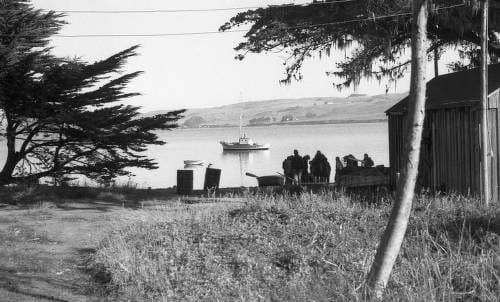The Democrats’ Biggest Kink is Losing
How powerlessness became an unconscious strategy for Democrats.
The end of cattle ranching in Point Reyes was hailed as an environmental win. But workers and tenants stand to pay the price.
Point Reyes National Seashore is famous for its open rolling landscapes where cows roam just a short drive from herds of native tule elk. These rustic vistas, dotted with working herds of grazing cattle, draw more than two million visitors a year. But a decades-long fight between ranchers and environmental activists may result in the cattle being removed from the landscape permanently, leaving the workers who care for them in limbo.
On January 8 of this year, Point Reyes National Seashore, conservation groups, and the ranch owners in the park finally agreed to a settlement voluntarily ending 12 beef and dairy ranching operations, with two beef operations deciding to continue their operations. Those who live and work on the ranches, the majority of whom are Latino, have been thrown into crisis. The end of ranching means they face eviction by 2026, with few prospects of staying in the community, or even county, they call home.
“There's a lot of people living in survival mode right now trying to figure out where their kids are going to be going to school, whether or not they're going to be able to have a little vacation during summer break, or if they're gonna be having to move,” said Jasmine Bravo, a tenant of one of the ranches currently facing closure.
“There's a lot of people living in survival mode right now trying to figure out where their kids are going to be going to school, whether or not they're going to be able to have a little vacation during summer break, or if they're gonna be having to move."
Rosa Rodriguez, also a tenant on one of the affected ranches, helped form the advocacy group Familias Afectadas de Rancho, to support workers and tenants on the ranches. Workers, their families, and other ranch tenants were left out of the consultation process for the settlement, she wrote in the local newspaper Point Reyes Light, calling on ranchers to ensure workers are compensated and included in transition planning going forward.
“National and regional news reports have focused on environmental benefits and the ranching families losing land and tradition,” Rodriguez wrote. “But missing from the conversation are our voices—the voices of the Latina and Latino farmworkers and tenants whose labor has sustained these ranches and this community for generations. We now face an uncertain future.”
“It is also essential to secure permanent, affordable housing and relocation assistance for all displaced workers and tenants, including our children, who are suffering daily alongside us,” Rodriguez wrote.
Marin County calls this threat to livelihoods a “shelter crisis.” In response, the Board of Supervisors voted on March 11 to approve loosening of regulations in unincorporated areas of West Marin to help workers and tenants.
Workers and tenants attended the meeting in support of the resolution, some wearing red and black to represent the colors of the flag of the United Farm Workers—a labor union with a storied history that has represented farmworkers since the 1960s.
Gabriel Romo, 26, who spoke at the meeting, said he is facing displacement from the home he was born and raised in on Point Reyes National Seashore.
“I have lived in Point Reyes my entire life. I know no other home. It is my community,” Romo said during public comment. “The priority seems to be tourism, not our community. But we will not be ignored.”
One ranch tenant, who gave his name as Enrique, held back tears as he addressed the supervisors in Spanish. “This is not enough. Right now we live under a tremendous amount of tension and pressure. I am a family man. I am the father of a son with an extreme disability. And as you can imagine the situation is very, very worrisome,” he said.“What will happen to us?”
While the vote is a step in the right direction, it does not provide funds to help build permanent or temporary housing or provide an explicit incentive or blueprint to do so.
The new settlement, which blindsided workers and tenants, is the culmination of a decades-long legal battle pitting the Center for Biological Diversity, Resource Renewal Institute, and Western Watersheds Project against the National Park Service. The conservation organizations have long-argued that ranching at the park was a detriment to the land (a claim which has been proven correct scientifically, although not legally), and contradicts the founding tenets of the National Park Service.

In response to the new settlement, Republican lawmakers launched an investigation that Democrats say could “blow up” the deal, according to KQED. In a letter to the Nature Conservancy, Republican members of the House Committee on Natural Resources alleged the terms of the settlement were “closely guarded” and that ranchers had been “muzzled” by NDAs they were required to sign in exchange for compensation.
But as disgruntled ranchers and conservative politicians duke it out with Point Reyes National Seashore and environmentalists, workers and tenants face an uncertain future.
It is estimated that somewhere between 90 and 150 people live on these lands, many of whom are workers’ children, meaning that in just over one year, they will all be evicted and have to find housing elsewhere. A vast majority of them live in housing provided by the ranch owners, meaning their bosses are also their landlords.
Housing costs in West Marin are incredibly high. The average rent for a two bedroom apartment in the county is $3,170 a month, according to Renthop. By contrast, ranch workers in West Marin earn somewhere between $27,000 and $48,400 a year, according to the Point Reyes Light.
Landlord-backed state laws banning rent control have resulted in places in the county being rented far above what many tenants can afford. Workers will be forced to look elsewhere for housing out of practicality. If nothing is done with the next couple of months, Bravo said, many working-class tenants will pack up and go.
As part of the settlement that has created this crisis in West Marin, a severance package will be given to the ranch workers. The exact amounts each household will receive is unknown. While this means not everyone living on the ranches will be without support to find housing, the cost of rent in Marin, like the rest of the Bay Area, is often cripplingly expensive. Some nonprofits are gearing up to help provide housing and funds for ranch workers and their families.
Currently, The Nature Conservancy, a nonprofit that was brought into the mediation only in the past year, has been helping manage a $2.5 million “ranch worker and tenant displacement fund” to help local ranch residents find stable housing. The Marin County Board of Supervisor Dennis Rodoni stated in his plan regarding next steps due to the settlement to “contribute significantly” to this fund. Still, for many workers, the future remains uncertain.
While the need now to find home for ranch workers and tenants is critical, this is not the only issue with housing on the ranches. For years, many of these homes have been in disrepair. Tenants have long reported issues with mold, poor ventilation, rotting floorboards, broken bathtubs, along with various fire hazards.
A 2023 study into housing conditions for low-wage workers in West Marin found that much of the county’s rental stock was in poor condition. The report, commissioned by the Committee for Housing Agricultural Workers and Their Families, found that Latino ranch workers and their families were most likely to live in substandard housing. More than three quarters of households interviewed for the study lived in housing with problems that Marin County Environmental Health Services would consider a “major violation.”

Carlos Porrata, an Inverness resident and photographer, has seen some of these living conditions first hand. His wife, a public health nurse, often provided care for ranch employees and tenants on the lands, and he followed her there. What he saw in some places shocked him.
“There's no dignity in living in some of those places,” Porrata said.
Porrata was quick to point out, however, that another option was possible. Some dairies at the north end of the park had much better housing. There, ranch and leaseholders have over the years helped refurbish some of these homes, while others have let them become destitute. In Porrata’s view, the core issue is ranch workers’ disempowerment.
“In the last 48 years I've been here, I have never been able to see ranch workers stand up and be able to either complain or try to make things better simply because the rancher could retaliate against them,” Porrata said, “and so they're scared most of the time, and I think that’s why it's very difficult to actually get one of the the ranch workers to actually speak about how things are and how they live.”
That ranch workers and tenants were never included in mediation conversations for the park is just one example of this. Bravo, pointed out that the workers—many of whom are immigrants— are left out of important conversations within their own communities, often being treated, she says, “as second class citizens.”
While the county has begun to take steps to address the issue, very little tangible change has arrived. There is hope of a low-income housing space on the Coast Guard premises in Point Reyes, but that is still under environmental review. Barring any major changes or windfalls for the tenants, West Marin will likely see many essential workers in its community pushed out for good.
“The people who live on the seashore are teachers, they work in the clinic, they work in the grocery stores, restaurants, they’re bakers,” Bravo said. “It's going to be very obvious to the community when they have to look for workers.”